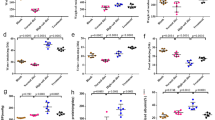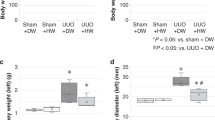Abstract
Progressive glomerular and tubulointerstitial fibrosis develop in 1-year-old rats even after relief (R) of unilateral ureteral obstruction (UUO) at 5 days of age. The present study investigated whether a progressive renal injury model of UUO could be achieved after reversal of UUO (RUUO) in adult instead of neonatal rats. The potential for α-tocopherol modulation of mRNA for the fibrogenic cytokine, transforming growth factor-β1 (TGFβ1), apoptosis (TUNEL assay), and the presence of the stress protein, heat shock protein-70 (HSP-70), was also studied in this post-obstructive model. Male Sprague-Dawley rats weighing 125–150 g were randomly assigned to groups of 4 animals each for durations of 7 or 14 days of α-tocopherol supplementation after RUUO. The groups included: (i) sham, regular chow; (ii) RUUO, regular chow; (iii) RUUO, contralateral nephrectomy (NX); and (iv) RUUO, NX plus α-tocopherol supplementation. We found a significant increase in the ratio of kidney weight/body weight in the RUUO+NX group at 14 days compared with the sham and RUUO groups. This rise in the RUUO+NX group was significantly reduced after 14 days of α-tocopherol administration. The elevated level of kidney TGFβ1 mRNA in the RUUO+NX group was only partially reduced at 7 days. But at 14 days this became significantly reduced with the continued α-tocopherol treatment. The HSP-70 staining and the apoptosis of the kidney showed results parallel to those of TGFβ mRNA at 14 days. To separate the effects of hypertrophy after unilateral NX from the RUUO studies, we carried out a second experiment in control animals subjected to NX, with and without α-tocopherol supplementation. Fourteen days after NX, the apoptosis and TGFβ1 mRNA showed no significant differences from the control animals. Our data suggest that a model of progressive renal injury in RUUO can be established in adult rats. After contralateral NX, the progressive injury is evidenced by the increase in the ratio of kidney weight/total body weight, the apoptotic counts, as well as fibrogenic cytokine TGFβ1 mRNA in the post- obstructed kidney. Finally, our data also support the concept that α-tocopherol is renal protective, as judged by TGFβ1 mRNA, apoptosis, and HSP-70 staining, even in the progressive disease process of the post-obstructed model.
Similar content being viewed by others
Author information
Authors and Affiliations
Additional information
Received: 17 February 2000 / Revised: 21 September 2000 / Accepted: 21 September 2000
Rights and permissions
About this article
Cite this article
Chan, W., Krieg Jr., R., Ward, K. et al. Progression after release of obstructive nephropathy. Pediatr Nephrol 16, 238–244 (2001). https://doi.org/10.1007/s004670000519
Issue Date:
DOI: https://doi.org/10.1007/s004670000519




